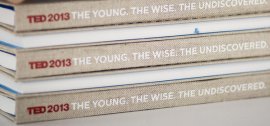Johanna Blakley
Media | Entertainment | FashionArchive for Inside TED
Inside TED: A Rare Glimpse Behind the Curtain
 Monday is sort of a ramp-up day at TED, but this year the highlight for me was Inside TED, a glimpse into the machinations of a unique organization that’s trying to figure out how to spread ideas that are stalled or stuck in some way – perhaps they’re trapped in impenetrable jargon; maybe they’re stuck in a disciplinary silo . . . or a Nairobi slum. Regardless of the impediments, or perhaps due to them, TED aspires to create a media platform for awesome and sexy ideas to propagate.
Monday is sort of a ramp-up day at TED, but this year the highlight for me was Inside TED, a glimpse into the machinations of a unique organization that’s trying to figure out how to spread ideas that are stalled or stuck in some way – perhaps they’re trapped in impenetrable jargon; maybe they’re stuck in a disciplinary silo . . . or a Nairobi slum. Regardless of the impediments, or perhaps due to them, TED aspires to create a media platform for awesome and sexy ideas to propagate.
Despite this expansive mission – based primarily on the notion that exposure and transparency are tools for solving the world’s problems – I think most TEDsters feel like there’s a tantalizing shroud of secrecy and sanctity enveloping the TED organization: exactly how many people work there? And how much money do they make from these hyper-expensive conferences (7,500 bucks a pop)? Who decides which videos are posted and featured?
Well, Inside TED was Chris Anderson’s way of opening up the ledgers and introducing the TED community to the brave (and wacky) souls who make this crazy ship run.
Some highlights:
- Revenues? About $45 million last year, with $27 million coming from TED, TED Global, and TED Active. Anderson estimates that there are about 500 core attendees who have spent around $30,000 supporting TED over the years.
- There are 1,400 talks on TED.com, with more than 50 million views per month. Only 200 are from TEDx events (and, so for, there have been 5,000 TEDx events with 8-10 more taking place per day.)
- 25% of their traffic is mobile, and they also distribute their talks through radio and TV channels (they’ve even put TED talks in taxis in Mumbai). Anderson suggested that TED speakers simply multiply their TED.com views by two in order to figure out about how many times their videos have been seen (that puts my two TED.com talks at 2.2 million views. Yowza.)
- Their brilliant open translation project involves 11,000 translators and 35,000 translations in 97 languages. (I was thrilled to hear that the Gates Foundation was a key funder for this. Go Bill!)
When someone asked Anderson about his favorite failure (and he had earlier admitted that the Bono TED Prize challenge to wire Ethiopia was a dire misfire) he ended up talking about their struggle to balance accessibility with substance. In order to get those great, inspiring ideas “unstuck” it’s essential to find a way to translate them to a larger diverse audience. The accusations, from several quarters, that TED “dumbs down” complex ideas were obviously deeply troubling to Anderson. His assertion that substance must always trump style is a challenging standard to be held to, especially for a slick global media platform like TED. And, honestly, to the rest of us bloggers and professors and public intellectuals who must find that precarious balance between accuracy and rigor and the ethical imperative to share important ideas with people who never thought they’d be interested.
If you’re at TED this week, look me up on TED Connect!














